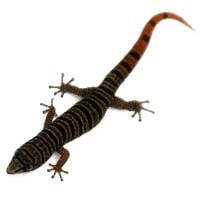Josh's Frogs
Ashy gecko (Sphaerodactylus elegans) Care and Breeding
 Adult Ashy Gecko
Adult Ashy Gecko
NAME
Adult ashy geckos (Sphaerodactylus elegans) have toned down colors, for which they are named. However, what the adults lack in coloration they make up for in extremely intricate patterning!
COLORATION
As juveniles, ashy geckos have remarkable coloring and patterning, with bold black bands down their body against a whitish head that leads to a bright yellow body. Their tails are bright orange to red. Adults are colored very differently, with a reddish brown body. They exhibit detailed patterning along their entire body, made up of beige dots and irregular lines. Unlike many micro geckos that are sexually dimorphic, both adult females and males are similar in color and pattern.
HOUSING
A pair of ashy gecko adults can be housed in an 8x8x12 enclosure or a 12x12x12 enclosure. As with other micro geckos, they are best kept solo or as a pair. Sphaerodactylus micro geckos are equipped with toe pads and can climb smooth surfaces like glass; because hatchlings and juveniles are very small, any accessible escape routes must secured!
Substrates like DigIt, Coco Select, and other coco-fiber based substrates work well. Sand-soil mixtures can also be used. A bioactive substrate can be made using BioBedding with springtails and isopods, offering your geckos additional food sources and reducing the need to spot clean. The substrate should be kept moist.
Ashy geckos are diurnal and terrestrial. Provide plenty of hiding places. A layer of leaf litter over the substrate is recommended, but additional hides should also be provided; cork bark and similar items can be used as hides. Live plants are always a welcome addition to the ashy gecko’s enclosure.
Though they are primarily terrestrial, ashy geckos are often found climbing and hanging out in elevated areas in their enclosure. Climbing material, like rocks, driftwood, cork bark, and manzanita branches, are recommended. While this species has not been observed digging, they’re small and at risk of being crushed. For this reason, we strongly recommend ensuring that any heavy enclosure items be securely placed and supported by the bottom of the enclosure instead of the substrate.
TEMPERATURE
During the day, ashy geckos should be kept at temperatures ranging from 75 to 80 F. A heat source is not necessary if stable temperatures are maintained. If a heat source is provided, use a low wattage heat pad or bulb to prevent overheating. Despite being a diurnal species, UV lighting for this species is a matter of debate. If UV light is used, a 2.0 or 5.0 bulb should be used, and plenty of shaded areas should be provided in the enclosure. Temperatures should not fall below 65 F at night.
Ashy geckos enjoy a higher humidity than other micro geckos, around 60-70%, but high ventilation and the enclosure being allowed to dry out between mistings are still important. This species should be misted daily or every other day to maintain an elevated humidity and to provide water droplets on the enclosure walls, leaf litter, and other cage items from which the geckos can drink. The enclosure should have enough ventilation that it dries out after several hours. A shallow water dish can be provided but is not necessary with consistent misting. Live plants will help create humid microclimates within the enclosure.
Both temperature and humidity should be monitored with a digital thermometer/hygrometer.
SIZE
Ashy geckos hatch out at only about 1.2 inches. Despite being one of the larger of the Sphaerodactylus micro geckos, adults are still very small, only reaching 2.7-2.8 inches from head to tail! It is estimated this gecko lives about 10-20 years in captivity.
DIET
Like all micro geckos, ashy geckos are insectivores. While their small size limits what bugs they can be offered in captivity, we supply all of the insects your ashy gecko will need. A staple diet of pinhead to ⅛-inch crickets works best for juveniles. Melanogaster fruit flies, springtails, and small dwarf white isopods can also be offered to juveniles. Adults should be fed a staple of ¼-inch crickets, but can also be offered extra small black soldier fly larvae, dwarf white isopods, hydei and melanogaster fruit flies, and bean beetles. Feeder insects should be gutloaded and dusted with a vitamin/mineral supplement. A food dish is not necessary but will help contain insects.
SEX
Because both males and females are similarly colored and patterned, ashy geckos are not as easy to sex as other micro geckos. Males are usually distinguished by light colored scales found along the underside of their hind legs.
BREEDING
A light brumation period in the winter or Increasing the length of day in the summer is recommended to incite breeding. Females will lay a single egg every three weeks in a secure area, including small egg-laying tubes. Eggs should be carefully removed and incubated. Eggs will hatch after 80-90 days.
Links of Interest:
http://www.reptilesmagazine.com/Wild-Lizards/American-Geckos/



